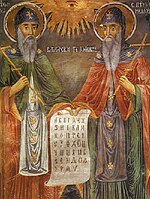基里爾和美多德
| 聖基里爾和聖美多德 | |
|---|---|
 | |
| Bishops and Confessors; Equals to the Apostles; Patrons of Europe; Apostles to the Slavs | |
| 出生 | 東羅馬帝國薩洛尼卡(位於今希臘) |
| 敬禮於 | 羅馬天主教會 保加利亞正教會 馬其頓正教會 東正教會 普世聖公宗 信義宗 |
| 瞻禮 | 2月14日(公曆);7月5日(1880-1886年的羅馬天主教會曆法);7月7日(1887-1969年的羅馬天主教會曆法) 5月11日(儒略曆,東正教沿用)[1] 7月5日(在捷克和斯洛文尼亞),5月24日(在保加利亞和北馬其頓) |
| 象徵 | brothers depicted together; Eastern bishops holding up a church; Eastern bishops holding an icon of the Last Judgment[2]Often, Cyril is depicted wearing a monastic habit and Methodius vested as a bishop with omophorion. |
| 主保 | 北馬其頓、保加利亞、捷克(包括波希米亞地區和摩拉維亞地區)、斯洛文尼亞[2] |
基里爾和美多德(希臘語:Κύριλλος καὶ Μεθόδιος,教會斯拉夫語:Кѷриллъ и Меѳодїи)是東羅馬帝國的傳教士。在傳播基督教正教的同時,他們同為基里爾字母的發明做出了巨大貢獻。他們同時被天主教會和東正教會封為聖人,被稱為「聖基里爾和聖美多德」。
簡介
[編輯]基里爾在西元826年或827年出生,原名為「康斯坦丁」,基里爾是他在羅馬成為修道士時取的聖名。美多德在825年或826年出生[3][3][4],原名為「米哈伊爾」,美多德是他在密細亞的奧林匹斯山成為修道士時取的聖名[5][6][7][8]。他們都出生在薩洛尼卡(位於現在的希臘)[9][10][11][12][13][14][15][16]。
860年,基里爾和美多德與受東羅馬帝國皇帝米海爾三世和君士坦丁堡牧首佛提烏的命令去可薩汗國阻止猶太教的擴張。因為可薩人信奉猶太教可以免除一些政治糾紛,可薩汗國可汗堅定地將猶太教作為國教,所以這次任務失敗了。
公元862年,大摩拉維亞的君主羅斯季斯拉夫要求東羅馬帝國皇帝米海爾三世和君士坦丁堡牧首弗提烏一世派傳教士給斯拉夫人傳福音。米海爾三世迅速選擇了派基里爾與美多德去,並且說:「你們來自薩洛尼卡,所有的薩洛尼卡人都講着純正的斯拉夫語[17]」公元863年,基里爾與美多德對大摩拉維亞和潘諾尼亞的斯拉夫人進行過傳教活動。為了向斯拉夫人傳教,他們利用希臘字母和一些自創的字母創造了格拉哥里字母。格拉哥里字母是第一種用來記錄古教會斯拉夫語的字母[18]。隨後他們將聖經翻譯成古教會斯拉夫語,並在摩拉維亞推廣了它。
在867年,教皇尼古拉一世邀請基里爾與美多德去羅馬,869年2月14日,基里爾在羅馬去世。870年,美多德返回摩拉維亞並在885年4月6日在那裡去世。
兩兄弟後來都被東正教會授予「斯拉夫人的傳教士」的頭銜。1880年,天主教教皇利奧十三世在天主教將他們的慶日加到天主教的禮儀曆中。1980年,天主教教宗若望·保祿二世宣布他們與諾爾恰的聖本篤同為歐洲的主保聖人[19]。
紀念
[編輯]


聖基里爾和聖美多德日
[編輯]信奉東正教的國家一般將儒略曆5月11日(公曆5月24日)定為「聖基里爾和聖美多德日」,而信奉天主教的國家一般將7月5日定為「聖基里爾和聖美多德日」。
現在,「聖基里爾和聖美多德日」 作為公共節日在下列國家慶祝:
- 在保加利亞人們在5月24日紀念基里爾與美多德,節日的正式名稱為「保加利亞教育、文化、和斯拉夫文學日」(保加利亞語:Ден на българската просвета и култура и на славянската писменост),一個用來紀念保加利亞文化、文學、與基里爾字母的節日。它被人們稱為「字母、文化和教育節」(保加利亞語:Ден на азбуката, културата и просвещението)。基里爾與美多德被看成是保加利亞國家圖書館的保護人。保加利亞國家圖書館前面就有他們的紀念館。
- 在馬其頓,人們在5月24日紀念基里爾與美多德,節日的名稱為「聖基里爾和聖美多德日」(馬其頓語:Св. Кирил и Методиј, Ден на словенските просветители)。
- 在俄羅斯,5月24日是「斯拉夫文學與文化節」(俄語:День славянской письменности и культуры),慶祝斯拉夫文學、文化與字母。
以他們名字命名的事物
[編輯]- 聖基里爾和美多德國家圖書館,位於保加利亞。
- 斯科普里聖基里爾和美多德大學,位於馬其頓共和國。
- 聖基里爾和美多德神學院,位於美國密歇根市。
參見
[編輯]注釋
[編輯]- ^ 在公曆中是5月24日
- ^ 2.0 2.1 Jones, Terry. Methodius. Patron Saints Index. [2014-12-21]. (原始內容存檔於2007-02-19).
- ^ 3.0 3.1 Methodius of Moravia - OrthodoxWiki. orthodoxwiki.org. [2021-04-23]. (原始內容存檔於2021-04-23).
- ^ Cyril and Methodius - OrthodoxWiki. orthodoxwiki.org. [2021-04-23]. (原始內容存檔於2021-05-11).
- ^ Cyril and Methodius, Encyclopedia Britannica 2005
- ^ Klasse, Akademie der Wissenschaften (Wien) Philosophisch-Historische. Denkschriften. Böhlau. 1870: 246 [2021-04-23]. (原始內容存檔於2021-04-23) (德語).
- ^ Chapter 18 of the Slavonic Life of Constantine (頁面存檔備份,存於網際網路檔案館), an English translation
- ^ English Translation of the 18th Chapter of the Vita Constantini, Liturgy of the Hours, Proper of Saints, 14 February
- ^ Columbia Encyclopedia, Sixth Edition. 2001-05, s.v. "Cyril and Methodius, Saints"; Encyclopedia Britannica, Encyclopedia Britannica Incorporated, Warren E. Preece - 1972, p.846, s.v., "Cyril and Methodius, Saints" and "Eastern Orthodoxy, Missions ancient and modern"; Encyclopedia of World Cultures, David H. Levinson, 1991, p.239, s.v., "Social Science"; Eric M. Meyers, The Oxford Encyclopedia of Archaeology in the Near East, p.151, 1997; Lunt, Slavic Review, June, 1964, p. 216; Roman Jakobson, Crucial problems of Cyrillo-Methodian Studies; Leonid Ivan Strakhovsky, A Handbook of Slavic Studies, p.98; V.Bogdanovich , History of the ancient Serbian literature, Belgrade, 1980, p.119
- ^ The Columbia Encyclopaedia, Sixth Edition. 2001-05, O.Ed. Saints Cyril and Methodius "Cyril and Methodius, Saints) 869 and 884, respectively, 「Greek missionaries, brothers, called Apostles to the Slavs and fathers of Slavonic literature."
- ^ Encyclopedia Britannica, Major alphabets of the world, Cyrillic and Glagolitic alphabets, 2008, O.Ed. "The two early Slavic alphabets, the Cyrillic and the Glagolitic, were invented by St. Cyril, or Constantine (c. 827–869), and St. Methodius (c. 825–884). These men were Greeks from Thessaloniki who became apostles to the southern Slavs, whom they converted to Christianity."
- ^ Hastings, Adrian. The construction of nationhood: ethnicity, religion, and nationalism. Cambridge: Cambridge University Press. 1997: 126. ISBN 0-521-62544-0.
. the activity of the brothers Constantine (later renamed Cyril) and Methodius, aristocratic Greek priests who were sent from Constantinople.
- ^ Fletcher, R. A. The barbarian conversion: from paganism to Christianity. Berkeley, Calif.: University of California Press. 1999: 327. ISBN 0-520-21859-0.
- ^ Cizevskij, Dmitrij; Zenkovsky, Serge A.; Porter, Richard E. Comparative History of Slavic Literatures. Vanderbilt University Press. : vi. ISBN 0-8265-1371-9.
"Two Greek brothers from Salonika, Constantine who later became a monk and took the name Cyril and Methodius.
- ^ The illustrated guide to the Bible. New York: Oxford University Press. 1998: 14. ISBN 0-19-521462-5.
In Eastern Europe, the first translations of the Bible into the Slavoruic languages were made by the Greek missionaries Cyril and Methodius in the 860s
- ^ Smalley, William Allen. Translation as mission: Bible translation in the modern missionary movement. Macon, Ga.: Mercer. 1991: 25. ISBN 978-0-86554-389-8.
The most important instance where translation and the beginning church did coincide closely was in Slavonic under the brothers Cyril, Methodius, with the Bible completed by A.D. 880 This was a missionary translation but unusual again (from a modern point of view) because not a translation into the dialect spoken where the missionaries were The brothers were Greeks who had been brought up in Macedonia,
- ^ Todd B. Krause; Jonathan Slocum. Old Church Slavonic Online Lesson 3. Linguistics Research Center at UT Austin. [2014-12-21]. (原始內容存檔於2010-10-02).
- ^ Liturgy of the Hours, Volume III, 14 February.
- ^ Egregiae Virtutis. [2014-12-21]. (原始內容存檔於2009-01-04). Apostolic letter of Pope John Paul II, 31 December 1980 (拉丁文)
- ^ Votruba, Martin. Holiday date. Slovak Studies Program. 匹茲堡大學. [2014-12-21]. (原始內容存檔於2011-05-14).
外部連結
[編輯]- (英文)The Life and Miracles of Saints Cyril and Methodius, Bishops and Apostles of the Christian Church
- (英文)wallpainting , St. Clemente
- (英文)Slavorum Apostoli by Pope John Paul II(頁面存檔備份,存於網際網路檔案館)
- (英文)Cyril and Methodius - Encyclical letter (Epistola Enciclica), 31 December 1980(頁面存檔備份,存於網際網路檔案館) by Pope John Paul II
- (英文)"Cyril and Methodius, Saints" article in Encyclopædia Britannica.
- (英文)^ The Columbia Encyclopedia, Sixth Edition, Cyril and Methodius, Saints.
- (英文)Catholic Encyclopedia: Sts. Cyril and Methodius (頁面存檔備份,存於網際網路檔案館)
- (英文)"Equal to Apostles SS. Cyril and Methodius Teachers of Slavs", by Prof. Nicolai D. Talberg (頁面存檔備份,存於網際網路檔案館)
- (英文)Catholic Culture (頁面存檔備份,存於網際網路檔案館)
- (英文)Cyril and Methodius at orthodoxwiki (頁面存檔備份,存於網際網路檔案館)
- (英文)Bulgarian Official Holidays, National Assembly of the Republic of Bulgaria: in English (頁面存檔備份,存於網際網路檔案館), in Bulgarian (頁面存檔備份,存於網際網路檔案館)
- (英文)Bank holidays in the Czech Republic, Czech National Bank: in English, in Czech
- (英文)"Landmarks of Culture", Russian Federation Agency of Culture and Cinematography, in Russian (頁面存檔備份,存於網際網路檔案館)
- (英文)US embassy in Bratislava's Embassy Holidays for 2006;
- (英文)British embassy in Bratislava's Embassy Holidays for 2006
- (英文)24 May - The Day Of Slavonic Alphabet, Bulgarian Enlightenment and Culture (頁面存檔備份,存於網際網路檔案館),
- (英文)Cyril at Patron Saints Index
- (英文)Saint Cyril in Orthodoxy
- (英文)Lettera Apostolica
